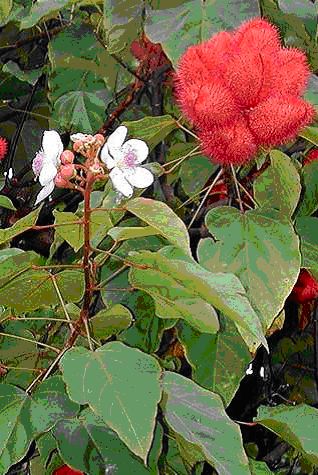|
|||||
|
|||||||
|
    An initiative of :Stichting Food-Info
|
| Food-Info.net> Food Products > Spices Annatto (Bixa orellana)Plant familyBixaceae (a family with only two representatives in South America). Botanical synonyms- OriginSouth America; Brazil is the main exporter. Today, annatto is also grown on the Philippines (introduced by the Spanish). Used plant partDark red seeds (about 3 mm diameter). Sensoric qualityAnnatto has a weak, perfumed odour. Main constituentsThe flowery scent of the seeds is caused by a tricyclic sesquiterpene hydrocarbon, ishwarane. The red colour is due to several apocarotenoids located in the seed epidermis, of which bixin (9' Z -6,6'-diapocarotene-6,6'-dioate) is the most important. Several more carotenoids and apocarotenoids have been identified; their total amount varies strongly, but may reach up to 7% of the dry seeds' mass. (Phytochemistry, 41 , 1201, 1996)
 Annatto (Source) UseAnnatto is native to South America, and is currently mostly in use as a flavouring and food colouring in Central and Northern South America. In the Caribbean, the seeds are usually fried in (animal or vegetable) fat; after discarding the seeds, the then golden-yellow fat is used to fry vegetables or meat. By this procedure, a golden yellow to golden brown colour is achieved. Mexican cooks often use a paste (achiote) of annato seeds with some preservatices (acetic acid) that dissolves completely in hot fat; it is easy to use and can also be added to marinades and sauces to improve the colour. The original Aztec drinking chocolate (see also vanilla) is reported to have contained annatto seeds as well; given their high fat content, this is entirely plausible. Using annatto to deepen the colour of chocolate was common in Europe until the 17th century. By Spanish influence, annatto also has made its way to South East Asia. On the Philippines, the seeds are often ground to a powder and added to soups and stews; meat is often marinated with annatto-coloured seasonings. The colour obtained hereby is brownish-yellow, less vibrant than the colour resulting from usage of annatto oil in the Caribbean. Main use of annatto nowadays is as a food colour, E160b Source : www-ang.kfunigraz.ac.at/~katzer/engl/spice_welcome.html |
|
| ||
| Food-Info.net is an initiative of Stichting Food-Info, The Netherlands | ||||||